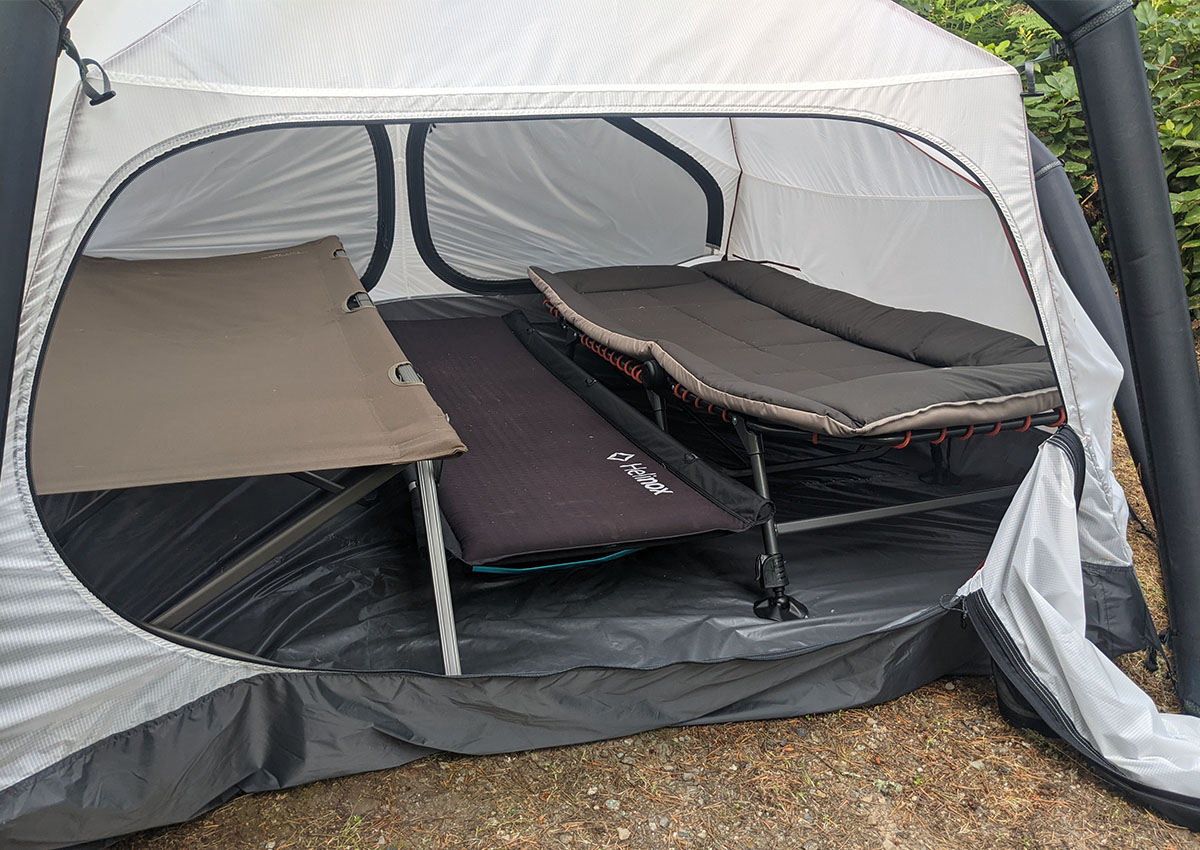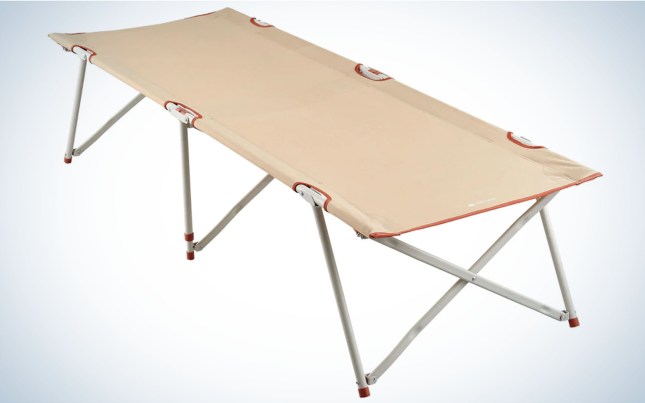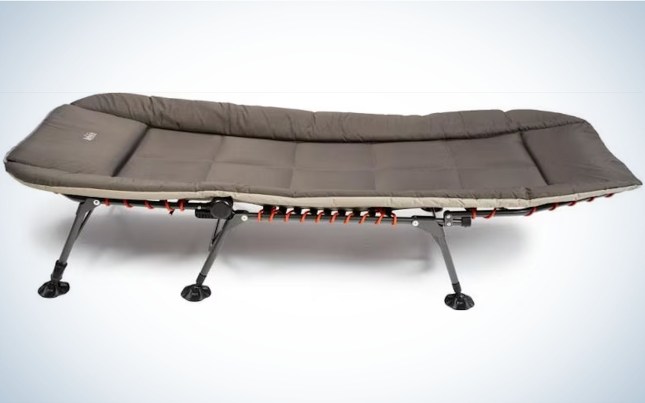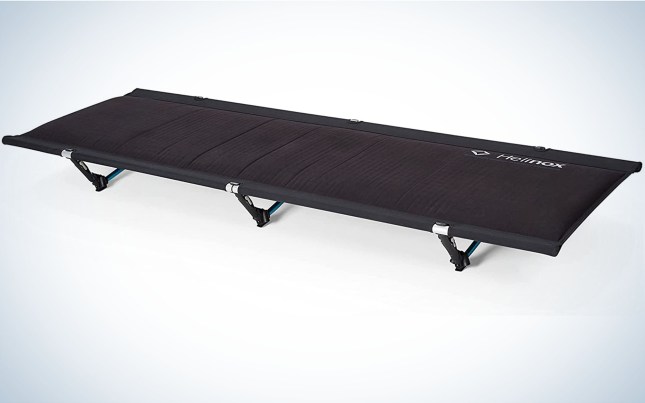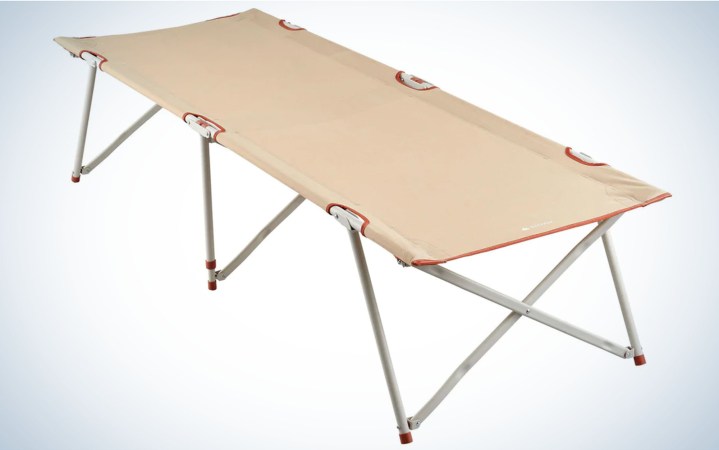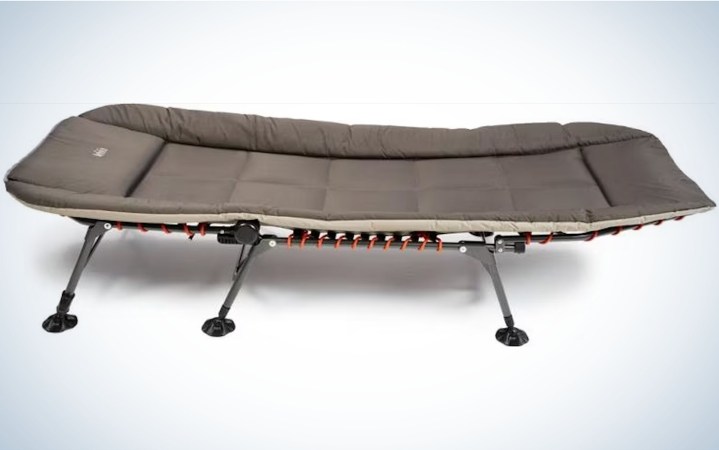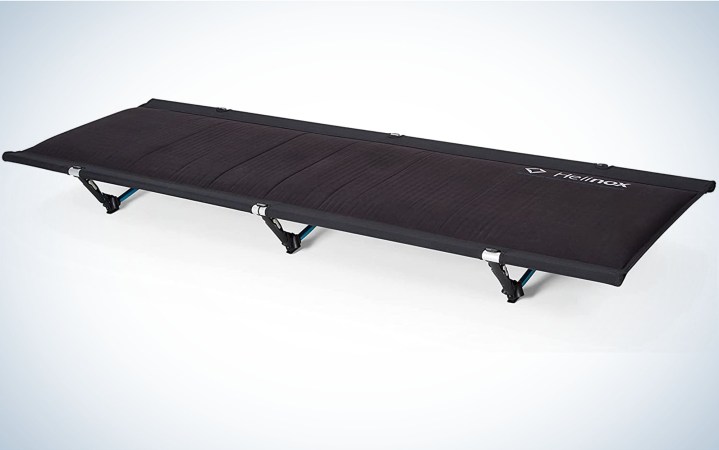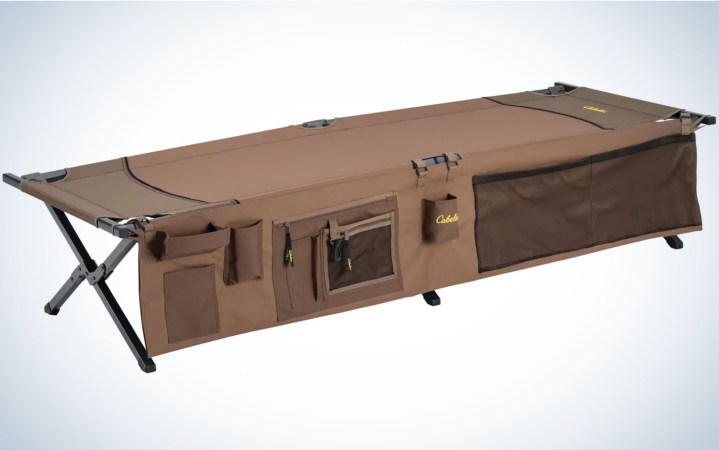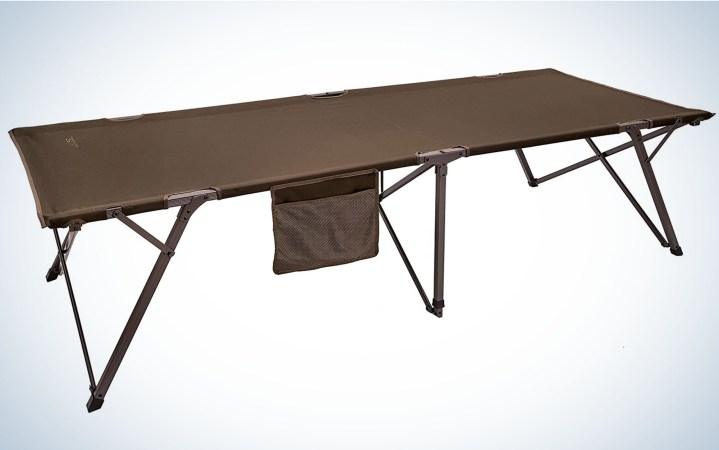We may earn revenue from the products available on this page and participate in affiliate programs. Learn More ›
Once you’ve got the basics of car camping down, it’s time to look at upgrading your setup: camp kitchen, camping hammocks, and camping cots. While most campers settle for sleeping on the ground while in the great outdoors, camping cots allow you to sleep more like you would at home, elevated above the ground, making it easier to get in and out of your sleeping bag at night. To help you choose the best camping cot, I tested five different models over a long weekend of car camping.
- Best Value: Decathlon Quechua Folding Camping Cot
- Most Comfortable: REI Co-op Kingdom Cot 3
- Warmest: Helinox Cot One Convertible Insulated
- Best Organization: Cabela’s Camp Cot with Organizer
- Best for Tall People: Alps Mountaineering Escalade
| Camping Cot | Price | Folded Size (L x W x H in inches) | Size (L x W x H in inches) | Weight | Weight Limit |
| Decathlon Quechua Folding Camping Cot | $70 | 38 x 5.5 x 5.5 | 74.8 x 25.6 x 17.7 | 16.5 pounds | 240 pounds |
| REI Co-op Kingdom Cot 3 | $200 | 33 x 32 x 8.5 | 82 x 31.5 x 14 | 20 pounds | 300 pounds |
| Helinox Cot One Convertible Insulated | $500 | 21 x 6 x 6 | 75 x 27 x 6.5 | 7 pounds | 320 pounds |
| Cabela’s Camp Cot with Organizer | $100 | 37.8 x 5.5 x 7.9 | 74.8 x 26 x 15.7 | 22 pounds | 300 pounds |
| Alps Mountaineering Escalade | $170 | 41 x 7 x 7 | 80 x 31 x 20 | 19.5 pounds | 325 pounds |
How I Tested the Best Camping Cots
Camping cots were tested on a four-day, multi-family car camping trip at Spencer Spit State Park. While my partner and I were the primary testers for these cots, we also shared them with other people on the group trip, soliciting a range of opinions as to what people did and did not like about what they were using. There were both long-time cot users and first-time cot users on this trip, so I was able to learn what both groups of people value.
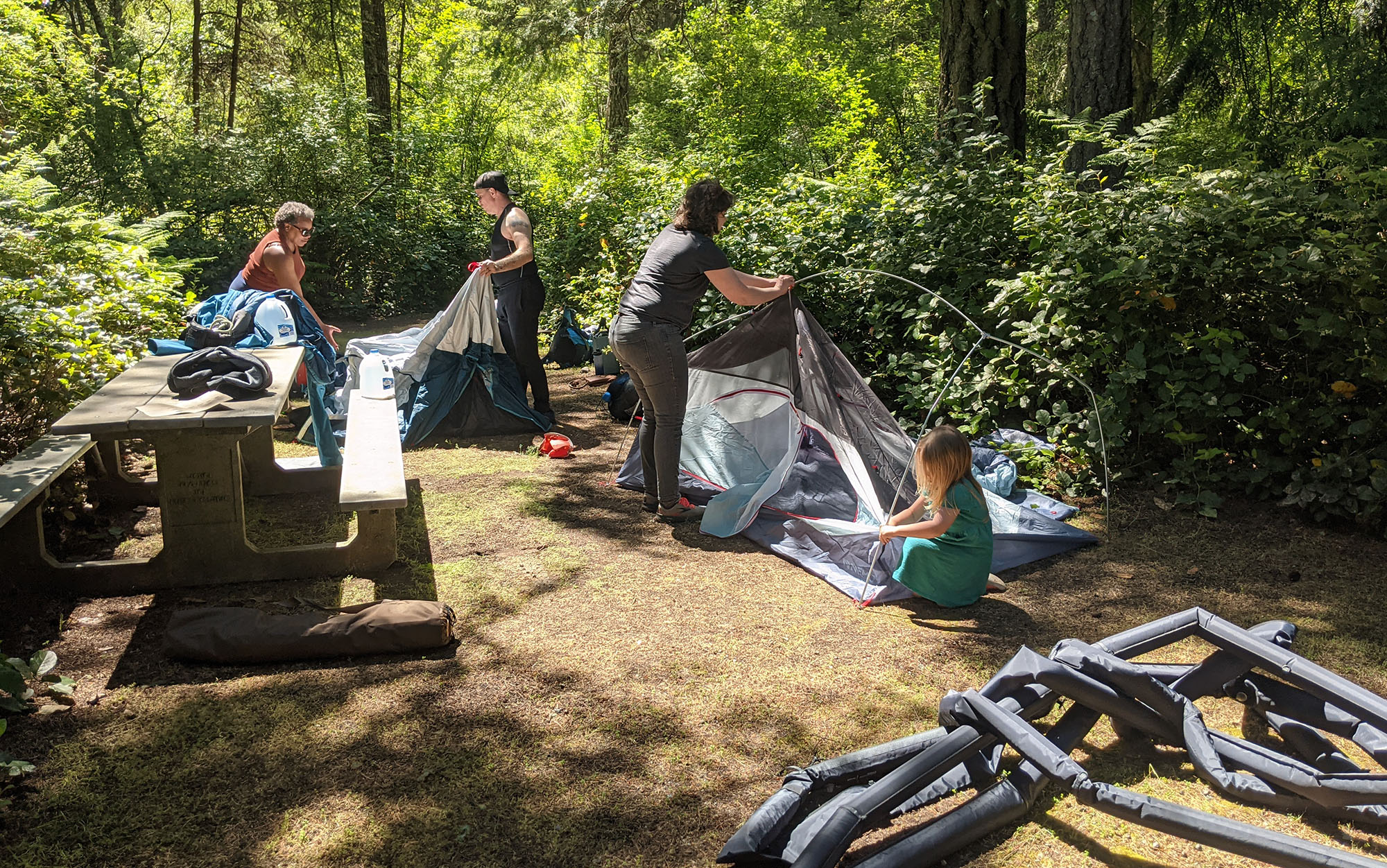
When assessing the cots, I took a number of factors into consideration. I looked at how much space they took up in my vehicle versus their size once they were set up at camp. Time to assemble and pack away again were taken into account, along with how difficult it was to get the cots into the various tents I was using on this trip. After sleeping in each cot (and talking to others about their experiences), I considered how comfortable (and warm) each was. Finally, prices and weight limits were taken into consideration.
Best Camping Cots of 2023: Reviews & Recommendations
Best Value: Decathlon Quechua Folding Camping Cot
Best Value
Decathlon Quechua Folding Camping Cot
Key Features
- Size: 74.8 inches long x 25.6 inches wide x 17.7 inches tall
- Weight: 16.5 pounds
- Packed Size: 38 inches long x 5.5 inches wide x 5.5 inches tall
- Weight Limit: 240 pounds
Pros
- Affordable
- Comparatively lightweight
Cons
- Not warm enough for shoulder season conditions or cold sleepers
- Lower weight limit than other picks on our list
I handed the Decathlon Quechua Folding Camping Cot over to some beginner campers at the start of my testing trip before heading off to figure out how to set up the tent I was testing. When I checked back in a short time later, they already had it set up and ready to go. And it’s easy enough to see why: The cot is hassle-free to unfold and includes straight-forward instructions on the inside of the carrying bag. During testing, it was as comfortable as the slightly higher priced Cabela’s camping cot and, for shorter people, the equivalent to the bulkier, higher-priced Escalade. If you’re looking to outfit the entire family with cots (which can run up a hefty price tag), then this one is a no-brainer.
The biggest issue here is the lack of insulation—a common issue among the camping cots I tested. While camping cots protect you from the cold of the ground by raising you up high, cold air flowing back and forth beneath you can still compromise the warmth of your sleeping bag. If you sleep cold or plan to use this cot in shoulder season conditions, consider pairing it with a high R-value sleeping pad like the Therm-a-Rest Basecamp.
Most Comfortable: REI Co-op Kingdom Cot 3
Most Comfortable
REI Co-op Kingdom Cot 3
Key Features
- Size: 82 inches long x 31.5 inches wide x 14 inches tall
- Weight: 20 pounds
- Packed Size: 33 inches long x 32 inches wide x 8.5 inches tall
- Weight Limit: 300 pounds
Pros
- Warmer than other cots I looked at
- Padded and comfortable
- Longest and widest camping cot in my test
Cons
- Massive packed size is impractical for most car camping setups
- Can spring back and cause minor injury if knobs are not secured prior to use
I’m glad I only tested one REI Co-op Kingdom Cot 3. It took up an inordinate amount of space in my Toyota 4runner, easily twice the space of the other camping cots. It was also so awkwardly shaped and prone to opening that I ended up packing for our three-night testing trip around this cot. This was such a serious issue that I would not bring this cot camping again for this reason alone.
But if you have endless space in your car camping setup, or are planning to park a camping cot in one spot and never move it, this is an excellent choice. It was the longest cot I looked at, the widest cot I looked at, and the most comfortable cot I looked at. It was also a lot warmer than the Cabela’s, Alps Mountaineering, or Decathlon cots, although REI has not assigned it an R rating for this purpose.
One note about this cot is that you’ll need to adjust the knobs on the side to get it to lay flat and stay there. During my initial testing I missed this detail and had the top of the cot spring back and strike me in the head with surprising force.
Warmest: Helinox Cot One Convertible Insulated
Warmest
Helinox Cot One Convertible Insulated
Key Features
- Size: 75 inches long x 27 inches wide x 6.5 inches high
- Weight: 7 pounds
- Packed Size: 21 inches long x 6 inches wide x 6 inches tall
- Weight Limit: 320 pounds
Pros
- Small packed size
- Lightweight
- Very warm (R value of 5)
- Padded top is comfortable
Cons
- Most complicated setup in my test
- Feels wobbly and tippy when you are getting up or down
- Very expensive
A problem I kept running into again and again with the camping cots in this test is that I was cold. I typically sleep on one of the best camping mattresses for couples or one of the best backpacking sleeping pads. Even though I’m sleeping closer to the ground with one of these options, they are much, much warmer, due to the insulation inside of the pad. While camping cots elevate you off the ground, they do little to protect you from the cold air whooshing back and forth underneath your cot all night. And your sleeping bag will struggle to protect you, too, since you are squashing all the insulation beneath your body and preventing it from lofting.
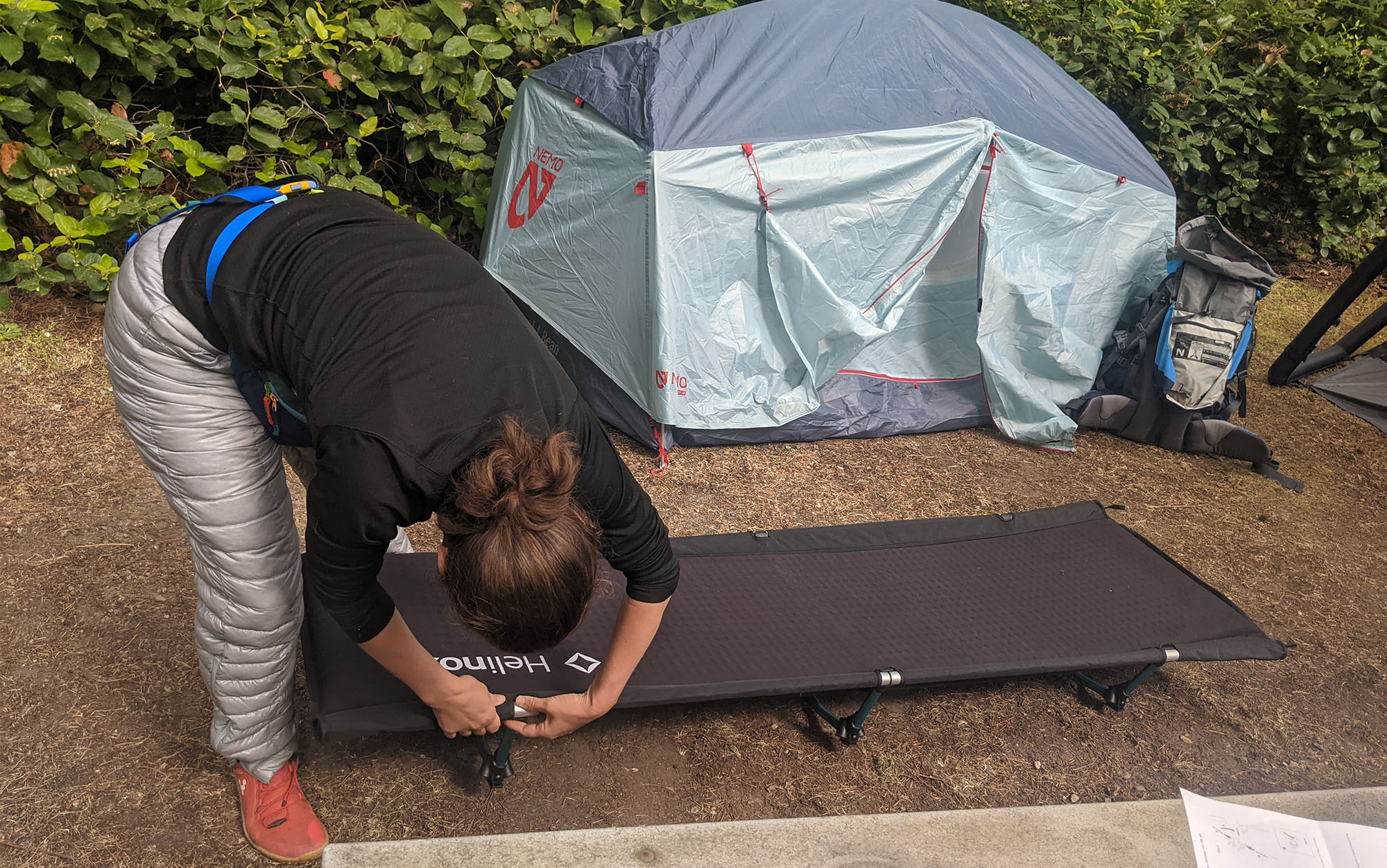
The only camping cot I found that dealt with this issue head on is the Helinox Cot One Convertible Insulated. It essentially integrates an inflatable sleeping pad with an R value of 5 into the cot setup, which kept me plenty warm on nights when temps dropped into the forties. The other major benefit to this cot is that it’s comparatively quite small, about half the size of the other camping cots in this test, and also very lightweight. That does come at a cost, however, both a literal one (this is seven times as expensive as my best value pick) and in the time it takes to set it up. It also didn’t get me all that high off the ground, although Helinox does sell legs separately that can be used to raise yourself up to a more typical camping cot height.
Best Organization: Cabela’s Camp Cot with Organizer
Best Organization
Cabela’s Camp Cot with Organizer
Key Features
- Size: 74.8 inches long x 26 inches wide x 15.7 inches tall
- Weight: 22 pounds
- Packed Size: 37.8 inches long x 5.5 inches wide x 7.9 inches tall
- Weight Limit: 300 pounds
Pros
- Low price
- Slightly more taut than other cots I looked at
- Organizational accessory attaches to cot
Cons
- Complicated setup
Something you notice the first time you set up camping cots is that they open up a significant amount of tent floor space for storage because now you can park some of your gear beneath the cots. But this supposed benefit can also be a problem when, as happened to us, the item that you happen to need while prepping your kid for bed is hidden beneath a cot on the opposite side of the tent. The organizer that comes with the Cabela’s Camp Cot helps to solve that issue by providing a series of pockets that can be used to store everything from your chapstick to your water bottle to your base layers.
The downside to this cot is that it has a more complicated setup and disassembly than the Decathlon Quechua Folding Camping Cot. After you’ve unfolded the legs and put them into position, there are two additional cross bars that must be secured at the head and foot of the cot. These were a little more difficult to get into place than I would have liked, but once they were in place it did increase the overall rigidity of the cot compared to either the Decathlon or the Alps Mountaineering options I looked at.
Best for Tall People: Alps Mountaineering Escalade
Best for Tall People
Alps Mountaineering Escalade
Key Features
- Size: 80 inches long x 31 inches wide x 20 inches tall
- Weight: 19.5 pounds
- Packed Size: 41 inches long x 7 inches wide x 7 inches tall
- Weight Limit: 325 pounds
Pros
- Highest weight limit in my test
- Second longest length in my test
- Comparative packed size to shorter cots
Cons
- Only camping cot in my test to suffer damage during assembly and disassembly
- Didn’t fit into all the tents in my test
One limitation of the Decathlon Quechua Folding Camping Cot is that it has a comparatively low weight limit: only 240 pounds. If you’re not quite petite enough to fit those parameters, the Alps Mountaineering Escalade may be what you’re after. With a weight limit of 325 pounds and a length of over six and a half feet, the Alps Mountaineering Escalade will fit a wider range of body types than other choices we looked at.
This cot suffered some issues during testing. The first is a corollary to its long length: it didn’t actually fit into the first tent we were going to test it out with, the Decathlon Pop Up Camping Tent. (It did fit in the four-person Heimplanet Backdoor, barely). If you don’t need this length and weight limit then you are better off with another pick on this list.
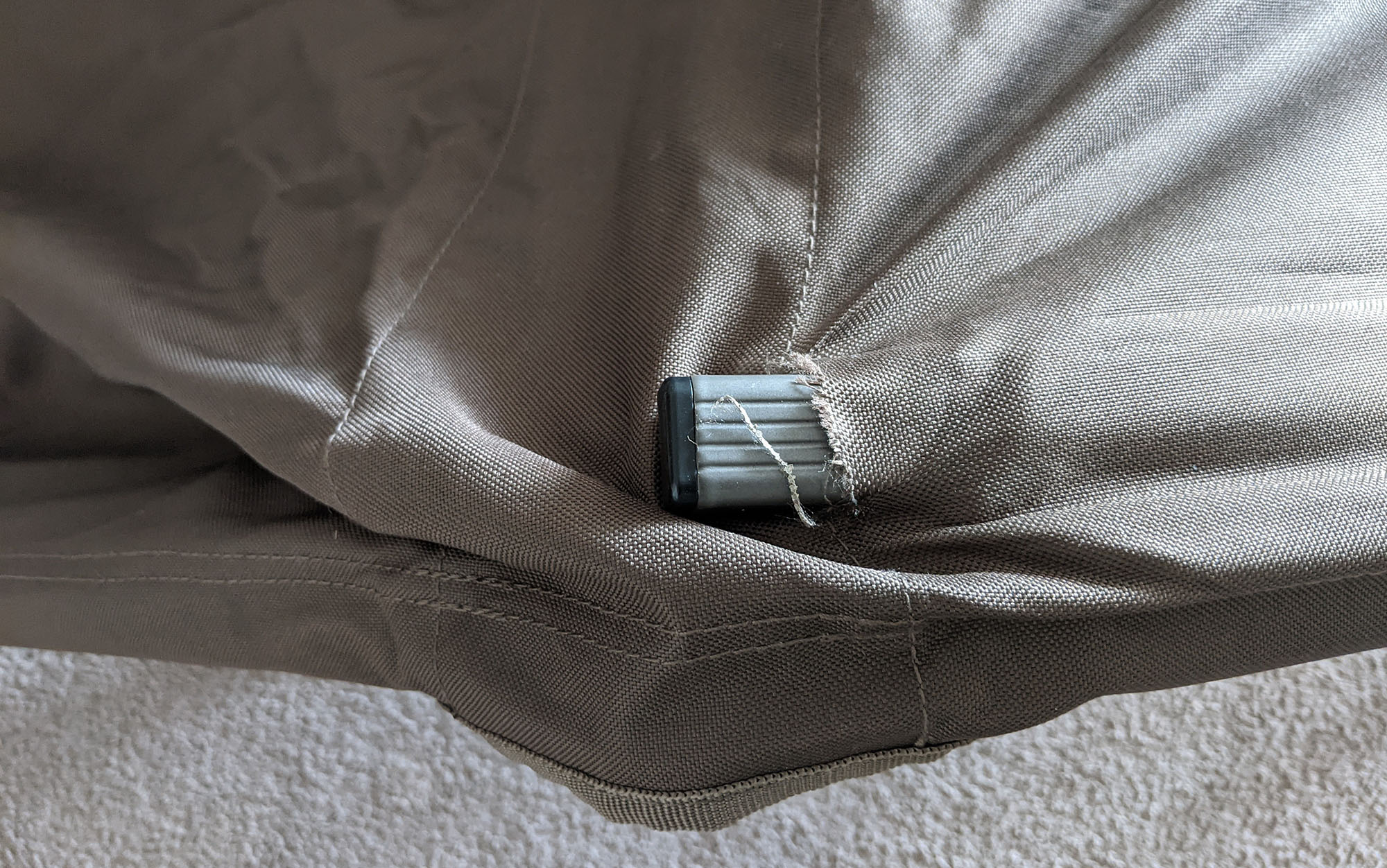
The Alps Mountaineering Escalade was also the only camping cot I looked at to suffer damage during testing, as a result of one of the slots for the support beams becoming misaligned and poking through the fabric during disassembly—something I didn’t even realize had happened until much later.
How to Choose the Best Camping Cots
Packed Size
Camping cots take up a surprising amount of room in a packed vehicle due to their long length. Before you purchase one for every member of your family, take a moment to look at the packed size specifications above and measure your vehicle to confirm that these dimensions work with the rest of your setup.
Setup Size
Camping cots also take up more space inside of your tent than a traditional sleeping pad. If you are upgrading multiple people to a camping cot, consider also upgrading to one of the best 8-person tents.
Weight Limit
There was a surprising amount of variation in the weight limits of the different camping cots I looked at, even when they appeared similar when set up side by side. If you are on the larger side, check that your chosen cot can support your weight before making a final purchase.
Warmth
Most camping cots will need the addition of a sleeping pad or mat to protect you from the cold air underneath the cot, even if you are using a traditional sleeping bag rated for cold-weather use.
FAQs
A camping cot needs a sleeping pad or mattress with a high-R value if you will be camping in colder (below 60 degrees at night) temperatures.
Camping cots are not more comfortable than high-quality camping mattresses to sleep on, although they are easier to get in and out of due to their distance from the ground.
The camping cots in Outdoor Life’s test of the best camping cots were 26 inches to 31 inches wide.
Why Trust Outdoor Life?
Since 1898, OL has been a leading authority in testing and reviewing hunting gear, fishing tackle, guns and shooting equipment, and much more. We have more than a century-long history of evaluating products, and we’re now bringing that expertise to online reviews. Our editors are experienced outdoorsmen and women, and most importantly, we’re trained journalists. We prioritize field testing and objective data when reviewing products. We conduct interviews with gear manufacturers and engineers as well as outdoor experts so that our readers have an understanding of how and why a product works—or doesn’t.
Advertising does not influence our gear reviews and it never will. While we always focus our coverage on standout products—because we want our readers to be aware of the latest and greatest gear—we also cover the flaws and quirks of any given product.
Final Thoughts on the Best Camping Cots
If you’ve been curious about trying a camping cot, there are a number of options at a wide range of price points and comfort levels to choose from. Keep in mind, however, that just moving your sleep system off the ground will not make it dramatically warmer. If you are considering a cot because you sleep cold, a better bet would be to look for a camping mattress with an R value over 5. However, most of these can be added to the below options for a great night’s sleep:
- Best Value: Decathlon Quechua Folding Camping Cot
- Most Comfortable: REI Co-op Kingdom Cot 3
- Warmest: Helinox Cot One Convertible Insulated
- Best Organization: Cabela’s Camp Cot with Organizer
- Best for Tall People: Alps Mountaineering Escalade
